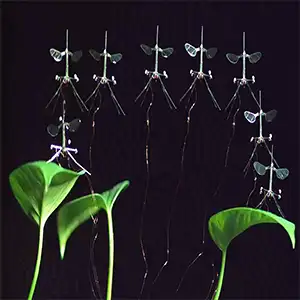Earth.com – Read More
The RoboBee can already fly, dive, and hover like a real insect. But there’s been one thing it couldn’t do very well – land safely.
Now, a team of engineers has finally tackled this critical challenge, giving the tiny flying robot a way to touch down without damaging its delicate parts.
This upgraded version of the RoboBee comes from the Harvard Microrobotics Laboratory at the John A. Paulson School of Engineering and Applied Sciences.
Scientists there took a cue from one of nature’s most elegant landers: the crane fly. Inspired by this insect, the team gave the robot long, jointed legs that allow it to settle gently onto a surface.
They also redesigned its control system so it can slow down as it approaches the ground, helping it to avoid harsh impact.
Why safe landing is so tricky
Despite being a major leap in microrobotics, RoboBee’s design has always come with challenges.
It weighs in at a miniscule tenth of a gram (0.004 ounces), even though it has a 3-centimeter (1.2 inch) wingspan.
That small size makes it vulnerable to instability near the ground – caused by swirling air from its own flapping wings. These turbulent forces, known as ground effect, can send the robot tumbling as it attempts to land.
“Previously, if we were to go in for a landing, we’d turn off the vehicle a little bit above the ground and just drop it, and pray that it will land upright and safely,” said Christian Chan, a graduate student who led the redesign of RoboBee’s mechanical structure.
Even with wings as small as RoboBee’s, the effects of moving air become intense during landing. That instability was a major threat to the robot’s flight muscles – called piezoelectric actuators – which are efficient but fragile.
What RoboBee’s new legs do
To give RoboBee a better chance at landing safely, the engineers turned to nature. They studied crane flies, which are often mistaken for giant mosquitoes and known for their slow, floppy flight patterns.
Crane flies also spend a lot of time taking off and landing, making them an ideal role model for the robotic equivalent.
“The size and scale of our platform’s wingspan and body size was fairly similar to crane flies,” Chan noted.

Crane flies have long, jointed legs that help soften the blow of landing. Using that as a guide, the researchers designed and built similar leg structures.
They used previous manufacturing techniques from the Microrobotics Lab to control how stiff or flexible each joint would be, thus fine-tuning the legs to handle different types of terrain.
A smarter brain for better control
Adding new legs was only part of the solution. The team also needed to train RoboBee’s brain to prepare for landing. That’s where the updated controller came in.
“The successful landing of any flying vehicle relies on minimizing the velocity as it approaches the surface before impact and dissipating energy quickly after the impact,” explained Nak-seung Patrick Hyun, who led the landing control tests.
“Even with the tiny wing flaps of RoboBee, the ground effect is non-negligible when flying close to the surface, and things can get worse after the impact as it bounces and tumbles.”
Hyun’s efforts included testing the robot’s landing performance on both soft and hard surfaces – including leaves – to ensure the system could adjust to different conditions.
Blending biology and robotics
Alyssa Hernandez, a postdoctoral researcher, added biological insight to the project. Her background in insect movement helped guide the robot’s leg design and landing behavior.
“RoboBee is an excellent platform to explore the interface of biology and robotics,” Hernandez said. “Seeking bioinspiration within the amazing diversity of insects offers us countless avenues to continue improving the robot. Reciprocally, we can use these robotic platforms as tools for biological research, producing studies that test biomechanical hypotheses.”
To support the work, the team also reviewed specimens from Harvard’s Museum of Comparative Zoology, where they compared leg structure and segmentation to refine their designs even further.
What’s next for RoboBee?
Right now, the RoboBee still relies on a tether for power and control. The team is working toward a fully autonomous version that will carry its own sensors, onboard computing, and energy source.
“The longer-term goal is full autonomy, but in the interim we have been working through challenges for electrical and mechanical components using tethered devices,” explained project lead Robert Wood.
“The safety tethers were, unsurprisingly, getting in the way of our experiments, and so safe landing is one critical step to removing those tethers.”

Removing the tether would unlock RoboBee’s full potential. The robot’s tiny size and insect-like agility make it a strong candidate for real-world tasks – like monitoring environments, aiding in search-and-rescue efforts, or even helping pollinate crops.
Chan has high hopes for that last idea. One of his favorite potential uses is artificial pollination. “Picture swarms of RoboBees buzzing around vertical farms and gardens of the future,” he suggested.
The full study was published in the journal Science Robotics.
—–
Like what you read? Subscribe to our newsletter for engaging articles, exclusive content, and the latest updates.
Check us out on EarthSnap, a free app brought to you by Eric Ralls and Earth.com.
—–






